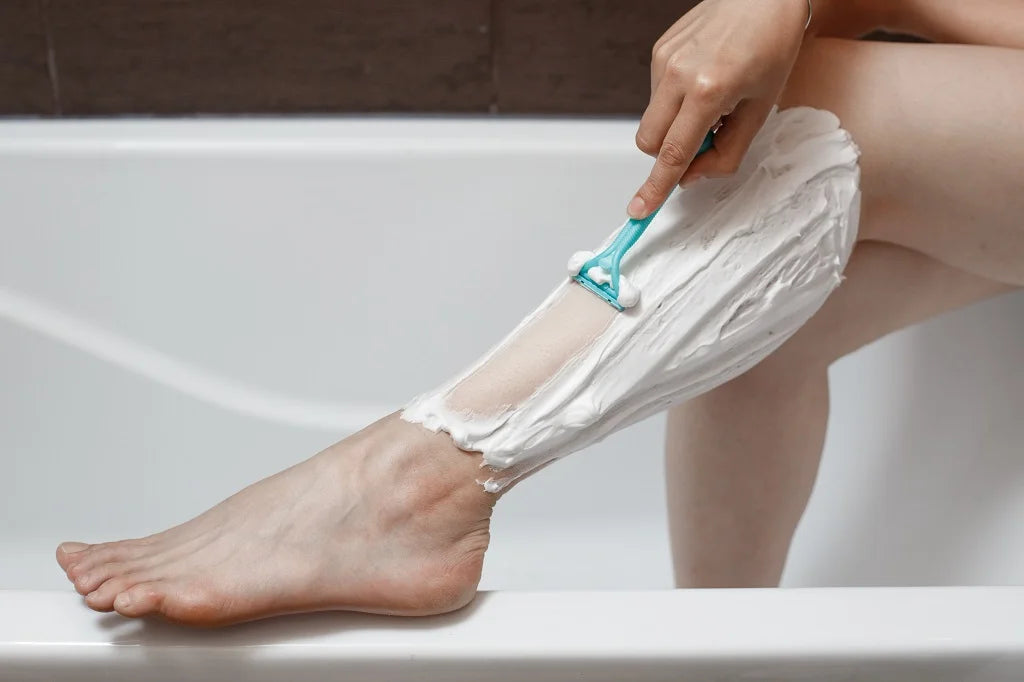
How to shave your legs without getting bumps?

Dr. Deepthi Prasad, MBBS.
Written by Our Editorial Team
Hello skin friends! Red legs after shaving? Don't worry anymore! Whether you have strawberry legs or chicken, we are here to help you explore the world of smoothness and find the secret to flawless skin.
Why am I getting bumps after shaving?
Let's get rid of the criminals behind these ugly balls. When your skin is inflamed and irritated, shaving is a hot culprit. Ingrown hairs that curl back or grow sideways create mounds of sneaky intruders. For people with sensitive skin, allergies and irritation can turn your shaving experience into a skin concern. But fear not, folks! We have the solutions you are looking forward to.
1. Razor Burn: The Fiery Culprit

Razor burn usually causes red bumps after shaving, commonly known as strawberry legs. It occurs when the skin becomes sore and irritated for many reasons, such as using a blunt razor, using too much force, or shaving against the veins.
2. Ingrown Hairs: The Sneaky Intruders

Ingrown hairs can interfere with shaving, causing swelling that looks like chicken skin. These problematic hairs can curl or grow on the skin, causing discomfort and redness leading to red spots. This occurs when they fail to rise out of the skin properly. Several factors contribute to their formation, including excessively short hair cuts during shaving and clogged hair follicles. To minimize the risk of ingrown hairs, it is recommended to exfoliate regularly before shaving in order to eliminate dead skin cells.
3. Sensitivity and Allergic Reactions: Delicate Skin Woes

If you have sensitive skin you might be dealing with pesky bumps and even find it edgy after shaving, right? Don’t worry we can find a way to stop those bumps from happening. The root cause behind such inconveniences often lies within the ingredients contained in certain shaving creams, gels, or aftershaves. These substances can trigger allergic reactions or exacerbate existing skin irritations. To effectively address this sensitivity, it is advisable to select products specifically formulated for sensitive skin and devoid of potential irritants.
How do I stop getting razor bumps?
1. Prep with Care
It is crucial to adequately prepare your skin beforehand. This can be achieved by either taking a warm shower or applying a warm towel to your legs. These actions serve to soften the hair and open the pores, thereby facilitating a smoother shaving process and minimizing the likelihood of irritation.
2. Use a Sharp Razor
Over time the blades do become dull at providing clean and close shaves. When the razors are sharp they glide effortlessly on the skin reducing the risk of nicks.It is highly recommended to replace those blades after 5-10 shaves. In order to increase the lifespan of the blade it is advisable to make sure to rinse off any debris or accumulated hair. It should be stored in a dry place to prevent rust and corrosion.
3. Shave with the Grain
Do remember to use light pressure and let the razor do all the work. Avoid long strokes as this could result in nicking the skin and instead look for the short ones and rinse the razor to prevent any further clogging. Shaving with grain is typically the stroke intended to be in the direction of the hair outgrowth which would make the process easy and free of any irritation or discomfort.
4. Gentle Touch
For a safer experience, it is advisable to refrain from the application of excessive force applied by the blade on the skin. The blade should smoothly glide over the skin in a gentle manner. It is vital for the blade to make optimal contact with the skin to allow a closer shave experience to prevent razor burns as the skin becomes irritated and inflamed due to friction caused by the razor. One should take time as it makes room for indulgence and a moment for self-care thereby reducing the nicks, cuts, and any sort of discomfort. Effective razor application of the skin can reduce significant chances of ingrown hair which is a major cause behind those bumps.
5. Exfoliate Regularly
It is vital for dead skin cells to be completely removed from the surface. This is achieved by applying exfoliation that prevents clogged pores and retains moisture. ThriveCo Bumps Eraser Exfoliating Scrub is a blend of natural ingredients that work to gently exfoliate the skin by removing the excess dead skin cells, dirt, and excess oil. Unlike any other harsh scrub, it provides a gentle experience suitable for all skin types. Make sure to check it out on thriveco.in
Buy ThriveCo Bumps Eraser Exfoliating Scrub
6. Moisturize and Soothe
Moisturizing is the practice that makes the skin soothing by dealing with hydration and preventing dryness with the associated roughness. It is suggested to look for products that contain ingredients like hyaluronic acid, glycerin, and shea butter that contain elements that are responsible for retaining moisture. It is important to make a selection of the blend which makes it suitable as per the skin type. If you scratch the surface of the skin the skin; if it forms a white crease this indicates the skin is void of moisture else vice-versa.
We would like to highlight the things that were discussed for shaving. It can be an experience that could be frustrating and irritating if bumps form as a result of shaving. There are several methodologies that could be adopted by following the guidelines provided by us. If these issues continue to persist it is high time for consultation with a highly specialized skin care professional to whom we could address our personal skin concerns. These are tips we brought to you for taking care of your skin and achieving the skin that you desire. Better late than never!
About Doctor :

Dr. Deepthi Prasad specializes in Dermatology, Cosmetology, and Aesthetic Dermatology and has been practicing for over 15 years. After completing MBBS from Dr. NTR University of Health Sciences Andhra Pradesh in 2009, she earned a MD in Dermatology, Venereology & Leprosy from Osmania Medical College in Hyderabad in 2014.
Disclaimer: All the content published on www.thriveco.in is solely for information purposes. It is not a substitute for professional medical advice, diagnosis, or treatment. Always consider seeking the advice of your physician or a qualified healthcare provider. The information, suggestion, or remedies mentioned on this site are provided without warranty of any kind, whether express or implied.
 Buy 2 Get 25% Off. Code: B2G25
Buy 2 Get 25% Off. Code: B2G25 






